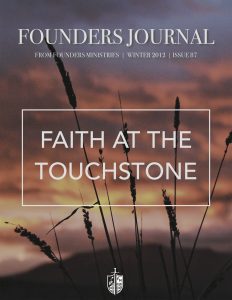Some of my best friends and my most admired heroes of the Christian faith believe in the practice of baptizing infants and bringing them into the membership of the church apart from any profession of faith. My love and respect for these dear brothers and venerable men of God has on more than one occasion inclined me to reconsider whether they’ve got it right and I’ve got it wrong.
But after “revisiting” the issue several times, I’m still a Baptist. I could offer several reasons. But one reason involves the teaching of a text that’s often overlooked in the Infant Baptism (Paedobaptism) vs Believer Baptism (Credobaptism) debate. That text is John 1:12–13. I’d like to make three observations on this text and explain why I believe it doesn’t support the idea of baptizing non-professing children of believers and bringing them into the membership of a New Covenant church.
Conferral of covenant sonship status under the New Covenant is limited no longer to the Jewish nation and is predicated no longer on natural descent but on supernatural descent, the fruit and evidence of which is saving faith in Jesus the Messiah. This is the point made by the apostle John when he writes, “But to as many as received Him, He granted the legal warrant to become children of God, even to the ones who believe in His name, who were born not of blood, nor of the will of the flesh, nor of the decision of a husband, but of God (John 1:12–13; author’s translation). Consider the following three observations and their implication for infant baptism and church membership.
A Shift in the “History of Salvation”
The reader should note that the primary theme of John 1:1–18 is the Word becoming flesh and dwelling among men. This is obviously a historical event and it marks a new epoch in the history of redemption. The apostle notes this epochal shift when he asserts, “The law was given through Moses; grace and truth came through Jesus Christ.” John’s reference to Moses alludes to a great event in redemptive history, viz, God redeeming His people from Egypt mediated through Moses and later revealed in the Law. That great redemptive event, however, would pale in comparison to the second great redemptive event. Indeed, the first great event was merely a shadow of the second great event. Now God would redeem His people from their sins by the hand of one greater than Moses (cf. Deuteronomy 18:15ff.; Hebrews 3:1–7). The Son of God would come and ratify a New Covenant with His own blood.
So what we have here are two mediators, two covenants and two canons! The “law” is the Old Testament canon completed. “Grace and truth,” refer to a New Covenant canon, not yet completed but anticipated and presupposed. Moreover, John’s purpose in this passage is to highlight the superiority of the New Covenant and its Mediator. The Old Covenant contained grace and truth (Exodus 34:4–7). That grace and truth, however, was promissory in form. God’s people could not look directly at His glory, but they could only see it as it was reflected from Moses’ face. Even then there was a veil over his face, because God’s people were not ready for the full revelation of God’s glory (Exodus 34:29–35).
But in the fullness of time God sent forth His Son, the Word. Now the veil will be taken away from the Law of Moses. Now God’s people are ready to see God’s glory in all of its fullness. Note verse 14: “And the Word became flesh, and dwelt among us, and we beheld His glory, glory as of the only begotten from the Father, full of grace and truth.” Now grace and truth are no longer in the promissory form of the Old Testament. Now they’re in the fulfillment form of the incarnate Son of God—the Mediator of a better covenant. Instead of sending Moses down from the mountain in order to reflect His glorious grace and truth, God Himself, in the person of Jesus Christ, has come down from the mountain. Note the declaration of verse 18: “The only begotten God who is in the bosom of the Father, He has explained [i.e., revealed] Him.” Jesus Christ Himself is the New Covenant Word from God.
What, therefore, verses 10–12 describe are human responses to this redemptive-historical event. “The world did not know Him” (v. 10), “His own people did not receive him” (v. 11), and “but as many as received Him” (v. 12) refer primarily those historical human responses that have followed in the wake of this new and greatest of all redemptive events—God become flesh in the person of Christ. Thus, verses 12 and 13 are not merely rehearsing God’s way of grace throughout the ages (e.g., God’s work of grace in Abraham, Moses and David) but are concerned primarily with a new state of affairs introduced by the coming of Christ and inauguration of the New Covenant. Now what once characterized only a remnant within God’s Old Covenant family will now be the rule characterizing the members of the New Covenant family. Unfortunately, as William Hendricksen notes, “The Jew was very slow to learn that in the new dispensation there are no special privileges based upon physical relationships” (emphasis added).1 Therefore, when a Paedobaptist (i.e., one who advocates infant baptism) asserts that John’s teaching in 1:12–13 “was true in the Old Covenant; this is nothing new,” it seems to me that he betrays an insensitivity to the clear redemptive-historical emphasis of John’s doctrine.
Accordingly, the passage is not simply explaining the “way of salvation” (ordo salutis), that is, God’s method of saving sinners at all times; it’s primarily highlighting a shift in redemptive history (historia salutis), that is, God’s manner of administrating the paradigm of redemption (commonly called the Covenant of Grace) in history.
Adoption: Legal Covenantal Status
The rendering of the Authorized Version, “to them gave he power to become the sons of God,” has suggested to some that verses 12–13 are dealing exclusively with regeneration. The Greek term translated “power,” however, is ἐξουσία (exousia), not δύναμις (dunamis). The later would connote revivification and be consonant with the grace of regeneration. The former denotes legal authority and/or privilege. This is noted by Leon Morris who writes, “John does not speak of power, as in the sense of power of sin (though in fact they receive that too). His thought is that of status. They have received full authority to this exalted title. He does not say ‘to be’ but ‘to become.’ Not only is there a status, but there is a change of status.”2 Albert Barnes argues similarly and prefers to translate ἐξουσίαν as “privilege.” He then identifies this privilege as the legal status of adoption.3 Barnes is not without support from other commentators. John Calvin uses the term “adoption” at least four times in his exposition of verses 12 and 13.4 Professor John Murray lists John 1:12–13 among “the most important passages in the New Testament bearing upon adoption.”5 He argues,
In John 1:12 he speaks of giving authority to become sons of God. Sonship, he indicates, is instituted by the bestowment of a right and this is to be distinguished from the regeneration spoken of in verse 13. When we apply John’s own teaching elsewhere to this passage we are compelled to discover the following progression of logical and causal relationship—regeneration (v. 13), the reception of Christ, the bestowment of authority, and becoming thereby children of God (v. 12)…. In a word, the representation of Scripture is to the effect that by regeneration we become members of God’s kingdom, by adoption we become members of God’s family.6
One should note how Murray connects the blessing of adoption with membership in God’s covenant family. Robert Peterson builds on Murray’s insights and remarks,
Adoption and regeneration are two ways of describing how we enter the family of God…. In regeneration, [God] begets his children, giving new life to those who were spiritually dead. In adoption, the Father places adult sons and daughters, former children of the devil, in his family. Adoption is a legal action, taking place outside of us, whereby God the Father gives us a new status in his family.7
So the grace bestowed in verse 12 is “adoption” in contrast with the grace effected in verse 13, which is “regeneration.”8 Of course, as the writers above note, John ties both salvific blessings together. This new covenant family status is conferred on believers (v. 12) whose very faith is itself the fruit or evidence of a supernatural work of God’s regenerating grace (v. 13). Thus, this newly conferred covenant status is not the product of human merit but of divine bestowal.
Nevertheless, since verse 13 stands grammatically in subordination to verse 12, the emphasis is not so much upon God’s inward work of regeneration but rather upon God’s subsequent conferral of legal status upon regenerate believers. And if John is not merely alluding to the ordo salutis but rather to a new stage in redemptive history, then his emphasis on a circumcised heart expressed by faith in Christ as the condition for the divine conferral of a new covenant-familial status suggests a qualitative difference between the constitutional makeup of the Old Covenant people of God, with the most of whom God was not well-pleased (1 Corinthians 10:1–5), and the New Covenant people of God, who, as a rule, are truly “a chosen race, a royal priesthood, a holy nation, a people for his own possession,” marked by the fact that God has not merely called them out of Egypt to Canaan but “out of darkness into his marvelous light” (1 Peter 2:9).
Consequently, the passage is not merely referring to the divine causation of a moral change in individuals, that is, regeneration; it’s primarily highlighting a divine conferral of legal covenantal status, that is, adoption.
Legal Basis of Covenant Status: Supernatural Descent
If, as argued above, John’s focus is not merely on the ordo salutis but primarily on the historia salutis, then verse 13 takes on new significance. Salvation has always been by grace through faith in the promised Offspring. More specifically, God has always called for a circumcised heart that gives rise to faith and genuine piety (Genesis 15:6; Deuteronomy 10:16; 30:6; Jeremiah 4:4, 14). But one might lawfully belong to Abraham’s “seed” and to the nation of Israel via the circumcision made with hands without the new birth. Hence, God confers upon the nation of Israel as a whole and indiscriminately the status of sonship (Exodus 4:22; Deuteronomy 14:1; Hosea 11:1; Romans 9:4).
This redemptive-historical state of affairs, however, has changed with the coming of Christ, says John. Not only does God convey His grace and truth through a better mediator than Moses (see above). Now God will limit the conferral of legal covenant status to those upon whose heart His law is written, who know Him, and whose sins He has forgiven (Jeremiah 31:31–34). To use the language of John, “To as many as received” the Son of God incarnate (v. 12). Hence, natural descent, the pride of the Jewish people, no longer counts. As Calvin observes,
The universal term ‘as many’ implies an antithesis: the Jews were carried away by a blind glorying, as if God were restricted to them alone. So the Evangelist declares that their lot has changed; the Gentiles have succeeded to the place left empty by the disinherited Jews. It is just as if he transferred the rights of adoption to strangers.9
So the legal right of entrance into the covenant family of God is no longer predicated on physical descent or outward circumcision. Instead, “‘Whosoever’ received Him,” notes Ryle, whether “Pharisees, Sadducees, learned or unlearned, male or female, Jews or Gentiles, to them He gave the privilege of sonship to God.”10 Hence, with the coming of Christ, God has reconstituted His covenant household. He has indicated through the pen of His inspired apostle that warrant for inclusion within His “covenant household” (see Ephesians 2:19) is predicated no longer on natural descent on faith and the new birth but on supernatural descent, the fruit and evidence of which is saving faith in Jesus Christ.
Implications for New Testament Baptism and Church Membership
What are the implications for the New Covenant rite of baptism and church membership status? According to one Paedobaptist pastor,
The passage teaches nothing concerning ‘baptism,’ the sign, but is concerned with the grace, or what is signified. Paedobaptists teach that the grace signified by baptism belongs only to those who believe. Paedobaptists are credobaptists in this sense.
I agree that “the grace signified by baptism belongs only to those who believe” and that “Paedobaptists are credobaptists in this sense.” I would also concede that John does not directly refer to water baptism (which would be a bit premature at this stage in his Gospel presentation). Nevertheless, I’m inclined to think, in light of my exposition above, that this passage does carry implications regarding the recipients of baptism and membership in New Covenant churches.
Under both the Abrahamic and Mosaic administrations, the “way of salvation” (ordo salutis) was preached primarily through shadows and was not, as a whole, realized in the “people of God.” Under the New Covenant, however, God’s redemptive program has advanced. Now the history of redemption (historia salutis) and way of salvation (ordo salutis) will more closely coincide. (Note: perfect coincidence will await the eschaton.) To achieve this result, God demands faith in Messiah as the warrant for inclusion within the New Covenant community. Natural descent and outward circumcision served their typical purposes under the Abrahamic and Mosaic covenants. But blood-ties to Abraham and removed foreskins failed to effect the kind of changes in the covenant community God ultimately desired. Therefore,
Finding fault with His people, He says: “Look, the days are coming,” says the Lord, “when I will make a new covenant with the house of Israel and with the house of Judah—not like the covenant that I made with their fathers on the day I took them by their hand to lead them out of the land of Egypt. Because they did not continue in My covenant, I disregarded them,” says the Lord. “But this is the covenant that I will make with the house of Israel after those days,” says the Lord: “I will put My laws into their minds, and I will write them on their hearts, and I will be their God, and they will be My people. And each person will not teach his fellow citizen, and each his brother, saying, ‘Know the Lord,’ because they will all know Me, from the least to the greatest of them. For I will be merciful to their wrongdoing, and I will never again remember their sins.” By saying, a new covenant, He has declared that the first is old. And what is old and aging is about to disappear [emphasis added] (Hebrews 8:8–13, HCSB).
In keeping with the redemptive-historical shift portended by the prophet Jeremiah, highlighted by the author of Hebrews, and reinforced by the teaching of John 1:12–13, I would argue that those who have divinely conferred legal warrant to enter into God’s newly constituted covenant family are those who give evidence of the new birth though a credible profession of faith in Jesus the Messiah. The fact that unregenerate men and women are sometimes baptized and brought into the New Covenant community on profession of faith that later turns out to be false does not contradict or invalidate the Credobaptist argument. Even the Paedobaptist predicates adult baptism on a credible profession of faith.
Hence, “the proverbial elephant sitting in the Credo-Baptist living room,” as one Paedobaptist brother put it, is in his living room too. The question is one of divinely bestowed legal warrant (John 1:12). What the Credobaptist avers is that this demand for a credible profession of faith as the warrant for inclusion within God’s New Covenant family is not a substantial continuation of the state of affairs under the Abrahamic and Mosaic covenants with, of course, a few minor changes, like the switch from circumcision to baptism and from the Passover to the Lord’s Supper. It is, rather, a new state of affairs from a redemptive-historical standpoint. Hence, the church and her leadership are no longer warranted by God to include physical seed in the covenant by virtue of mere blood-ties to believing parents. To those who receive Christ and to those alone does God grant de jure the privilege of New Covenant member status.
In closing, I acknowledge that some of my Paedobaptist brothers may affirm most of what I have said and acknowledge its validity as a general rule. They will, however, quickly remind me of a handful of New Testament passages that, in their minds, provide biblical warrant for an exception to the rule. They will point to Jesus’ receptive disposition toward children (Acts 18:1–10; Mark 10:14–16), Acts 2:38–39; household baptisms (Acts 16:15; 31–34; 18:8; 1 Corinthians 1:16), and the children made “holy” text (1 Corinthians 7:14). But these passages are hardly conclusive and undisputed. It should also be noted in that in all the New Testament polemic against the Judaizers’ attempt to foist the continuing demand of outward circumcision upon the New Covenant community never once do the apostles settle the confusion with the simple observation that circumcision has been superseded by baptism. Colossians 2:11–12 does not replace outward circumcision with water baptism. Rather, it replaces outward circumcision with inward circumcision (Philippians 3:3), i.e., regeneration, which in turn is evidence by faith (John 1:12–13) and symbolized in water baptism (Colossians 2:12). So, with all due respect and appreciation for my Paedobaptist brothers, I do not believe that the Credobaptists argues in a “void.”
Well, this is one reason why I’m still a Baptist. There are others too. But I still love and respect my dear friends and esteemed heroes in the faith who see things differently. In essentials unity. In non-essentials liberty. In all things charity.
Notes:
1 William Hendricksen, Exposition of the Gospel According to John (Grand Rapids, MI: Baker, 1953), 1:81.
2 Leon Morris, The Gospel According to John (Grand Rapids, MI: Eerdmans, 1971), 98.
3 Albert Barnes, Barnes’ Notes on the New Testament (Grand Rapids, MI: Kregel, 1962), 265.
4 See Calvin’s New Testament Commentaries (Grand Rapids, MI: Eerdmans, 1993), 4:16–19.
5 John Murray, Collected Works (Edinburgh: Banner of Truth, 1977), 2:226.
6 Ibid., 2:228–229.
7 Robert Peterson, Adopted by God (Phillipsburg, NJ: Presbyterian and Reformed, 2001), 105.
8 See also J. C. Ryle, Expository Thoughts on the Gospels (Grand Rapids, MI: Zondervan, 1957), 3:16–17.
9 Calvin’s New Testament Commentaries, 4:16–17.
10 Ryle, Expository Thoughts, 3:22.























